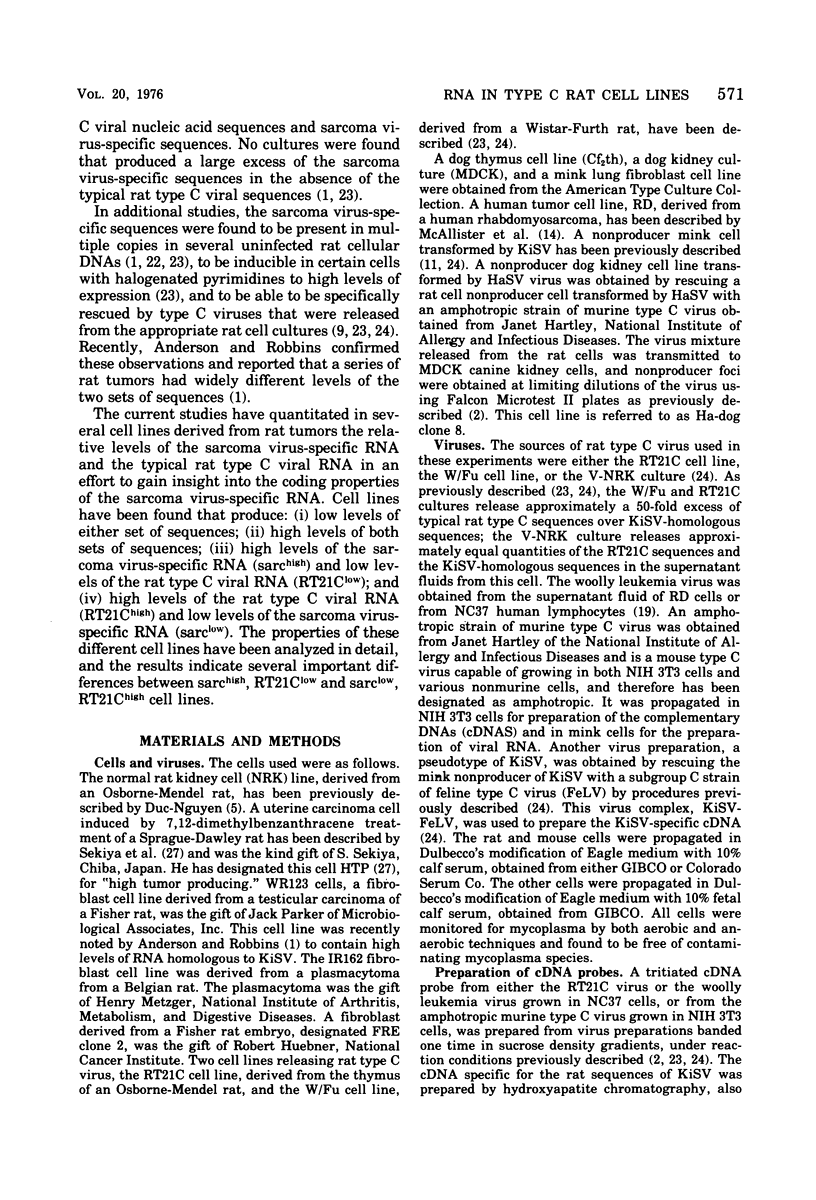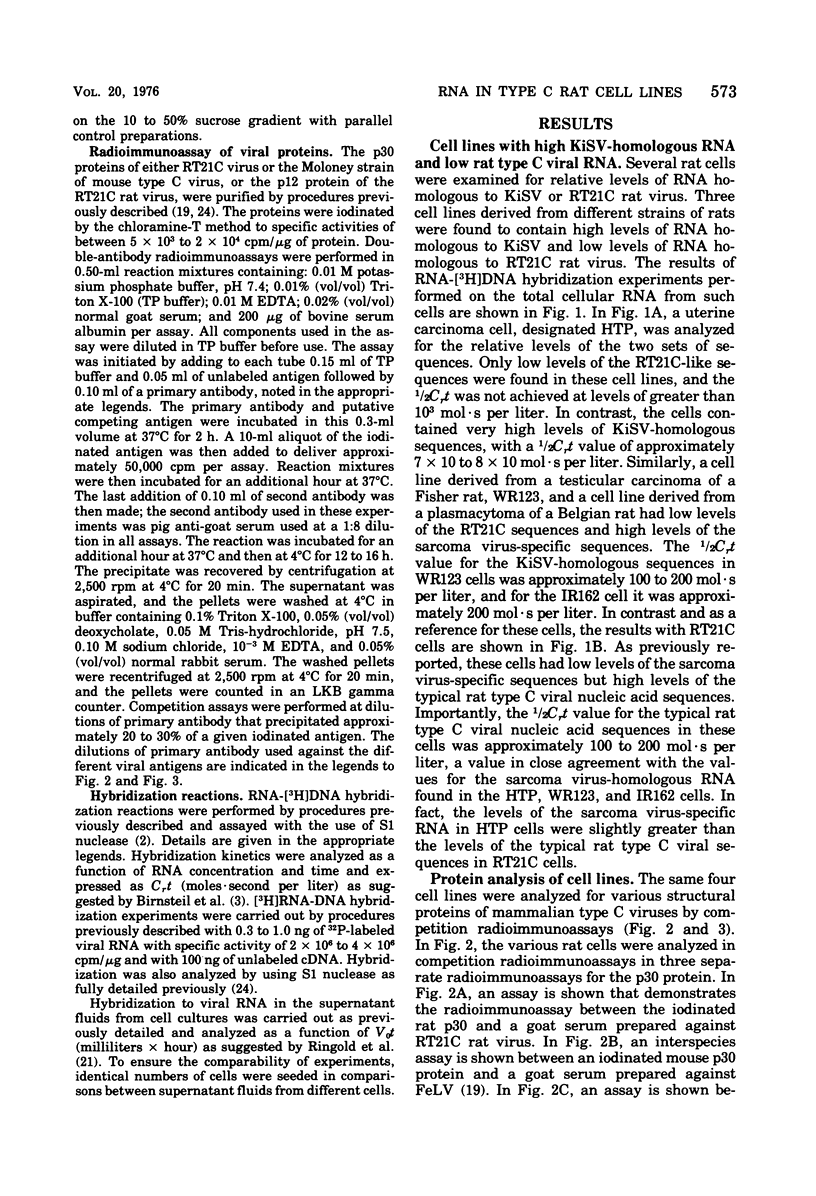Abstract
Various rat cell lines have been analyzed for expression of endogenous RNA homologous either to RT21C, a typical rat type C virus, or to Kirsten sarcoma virus. Cells have been found that express either (i) high levels of RNA homologous to RT21C rat type C virus and low levels of RNA homologous to Kirsten sarcoma virus (RT21Chigh,sarclow) or (ii) high levels of RNA homologous to Kirsten sarcoma virus and low levels of RNA homologous to typical rat type C virus (sarchigh, RT21Clow). The properties of these two classes of cell lines have been compared. Each type of cell contains an equal amount of the expressed RNA on polysomes. Cell lines that are RT21Chigh produce abundant rat p30 nad p12 structural proteins and release rat type C particles containing viral RNA and reverse transcriptase into supernatant fluids from these cultures. Cell lines that are sarchigh,RTC21Clow have no detectable rat viral p12 protein and no p30 protein immunoreactive in even broad interspecies radioimmunoassays, and do not release type C particles into the supernatant from the cultures. When the particle-negative cell lines are superinfected with heterologous mouse or wooly type C viruses or are producing typical rat type C virus particles, the endogenous sarcoma virus-specific RNA is secreted from these cells. The sarcoma virus-specific RNA can be transcribed in complementary DNA in the endogenous reverse transcriptase reactions carried out in vitro with such virus preparations. However, exposure of cells that are permissive to the helper virus with the particles containing sarcoma virus-specific RNA has not yet resulted in cell transformation or in the synthesis of these RNA sequences. The results suggest: (i) that the first step in the genesis of sarcoma viruses involves the packaging of this expressed sarcoma virus-specific RNA in helper viral particles; (ii) that efficient transmission of the sarcoma virus-specific RNA requires additional events; and (iii) that the formation of a stable sarcoma virus by recombination between the helper viral genome and part of the rescued sarcoma virus-specific RNA is much less common event than the rescue process itself.
Full text
PDF












Selected References
These references are in PubMed. This may not be the complete list of references from this article.
- Anderson G. R., Robbins K. C. Rat sequences of the Kirsten and Harvey murine sarcoma virus genomes: nature, origin, and expression in rat tumor RNA. J Virol. 1976 Feb;17(2):335–351. doi: 10.1128/jvi.17.2.335-351.1976. [DOI] [PMC free article] [PubMed] [Google Scholar]
- Benveniste R. E., Scolnick E. M. RNA in mammalian sarcoma virus transformed nonproducer cells homologous to murine leukemia virus RNA. Virology. 1973 Feb;51(2):370–382. doi: 10.1016/0042-6822(73)90436-4. [DOI] [PubMed] [Google Scholar]
- Birnstiel M. L., Sells B. H., Purdom I. F. Kinetic complexity of RNA molecules. J Mol Biol. 1972 Jan 14;63(1):21–39. doi: 10.1016/0022-2836(72)90519-0. [DOI] [PubMed] [Google Scholar]
- Brian D. A., Thomason A. R., Rottman F. M., Velicer L. F. Properties of feline leukemia virus. III. Analysis of the RNA. J Virol. 1975 Sep;16(3):535–545. doi: 10.1128/jvi.16.3.535-545.1975. [DOI] [PMC free article] [PubMed] [Google Scholar]
- Duesberg P., Vogt P. K., Beemon K., Lai M. Avian RNA tumor viruses: mechanism of recombination and complexity of the genome. Cold Spring Harb Symp Quant Biol. 1975;39(Pt 2):847–857. doi: 10.1101/sqb.1974.039.01.099. [DOI] [PubMed] [Google Scholar]
- Fan H., Baltimore D. RNA metabolism of murine leukemia virus: detection of virus-specific RNA sequences in infected and uninfected cells and identification of virus-specific messenger RNA. J Mol Biol. 1973 Oct 15;80(1):93–117. doi: 10.1016/0022-2836(73)90235-0. [DOI] [PubMed] [Google Scholar]
- Glisin V., Crkvenjakov R., Byus C. Ribonucleic acid isolated by cesium chloride centrifugation. Biochemistry. 1974 Jun 4;13(12):2633–2637. doi: 10.1021/bi00709a025. [DOI] [PubMed] [Google Scholar]
- Goldberg R. J., Levin R., Parks W. P., Scolnick E. M. Quantitative analysis of the rescue of RNA sequences by mammalian type C viruses. J Virol. 1975 Jan;17(1):43–50. doi: 10.1128/jvi.17.1.43-50.1976. [DOI] [PMC free article] [PubMed] [Google Scholar]
- HARVEY J. J. AN UNIDENTIFIED VIRUS WHICH CAUSES THE RAPID PRODUCTION OF TUMOURS IN MICE. Nature. 1964 Dec 12;204:1104–1105. doi: 10.1038/2041104b0. [DOI] [PubMed] [Google Scholar]
- Henderson I. C., Lieber M. M., Todaro G. J. Mink cell line Mv 1 Lu (CCL 64). Focus formation and the generation of "nonproducer" transformed cell lines with murine and feline sarcoma viruses. Virology. 1974 Jul;60(1):282–287. doi: 10.1016/0042-6822(74)90386-9. [DOI] [PubMed] [Google Scholar]
- Huu Duc-Nguyen, Rosenblum E. N., Zeigel R. F. Persistent infection of a rat kidney cell line with Rauscher murine leukemia virus. J Bacteriol. 1966 Oct;92(4):1133–1140. doi: 10.1128/jb.92.4.1133-1140.1966. [DOI] [PMC free article] [PubMed] [Google Scholar]
- Kerr I. M., Olshevsky U., Lodish H. F., Baltimore D. Translation of murine leukemia virus RNA in cell-free systems from animal cells. J Virol. 1976 May;18(2):627–635. doi: 10.1128/jvi.18.2.627-635.1976. [DOI] [PMC free article] [PubMed] [Google Scholar]
- Maisel J., Klement V., Lai M. M., Ostertag W., Duesberg P. Ribonucleic acid components of murine sarcoma and leukemia viruses. Proc Natl Acad Sci U S A. 1973 Dec;70(12):3536–3540. doi: 10.1073/pnas.70.12.3536. [DOI] [PMC free article] [PubMed] [Google Scholar]
- Maisel J., Scolnick E. M., Duesberg P. Base sequence differences between the RNA components of Harvey sarcoma virus. J Virol. 1975 Sep;16(3):749–753. doi: 10.1128/jvi.16.3.749-753.1975. [DOI] [PMC free article] [PubMed] [Google Scholar]
- McAllister R. M., Melnyk J., Finkelstein J. Z., Adams E. C., Jr, Gardner M. B. Cultivation in vitro of cells derived from a human rhabdomyosarcoma. Cancer. 1969 Sep;24(3):520–526. doi: 10.1002/1097-0142(196909)24:3<520::aid-cncr2820240313>3.0.co;2-m. [DOI] [PubMed] [Google Scholar]
- Naso R. B., Arcement L. J., Wood G., Saunders T. E., Arlinghaus R. B. The cell-free translation of Rauscher leukemia virus RNA into high molecular weight polypeptides. Biochim Biophys Acta. 1975 Mar 10;383(2):195–206. doi: 10.1016/0005-2787(75)90261-0. [DOI] [PubMed] [Google Scholar]
- Parks W. P., Scolnick E. M. Radioimmunoassay of mammalian type-C viral proteins: interspecies antigenic reactivities of the major internal polypeptide. Proc Natl Acad Sci U S A. 1972 Jul;69(7):1766–1770. doi: 10.1073/pnas.69.7.1766. [DOI] [PMC free article] [PubMed] [Google Scholar]
- Peacock A. C., Dingman C. W. Molecular weight estimation and separation of ribonucleic acid by electrophoresis in agarose-acrylamide composite gels. Biochemistry. 1968 Feb;7(2):668–674. doi: 10.1021/bi00842a023. [DOI] [PubMed] [Google Scholar]
- Roy-Burman P., Klement V. Derivation of mouse sarcoma virus (Kirsten) by acquisition of genes from heterologous host. J Gen Virol. 1975 Aug;28(2):193–198. doi: 10.1099/0022-1317-28-2-193. [DOI] [PubMed] [Google Scholar]
- Scolnick E. M., Goldberg R. J., Williams D. Characterizatiion of rat genetic sequences of Kirsten sarcoma virus: distinct class of endogenous rat type C viral sequences. J Virol. 1976 May;18(2):559–566. doi: 10.1128/jvi.18.2.559-566.1976. [DOI] [PMC free article] [PubMed] [Google Scholar]
- Scolnick E. M., Maryak J. M., Parks W. P. Levels of rat cellular RNA homologous to either Kirsten sarcoma virus or rat type-C virus in cell lines derived from Osborne-Mendel rats. J Virol. 1974 Dec;14(6):1435–1444. doi: 10.1128/jvi.14.6.1435-1444.1974. [DOI] [PMC free article] [PubMed] [Google Scholar]
- Scolnick E. M., Parks W. P. Harvey sarcoma virus: a second murine type C sarcoma virus with rat genetic information. J Virol. 1974 Jun;13(6):1211–1219. doi: 10.1128/jvi.13.6.1211-1219.1974. [DOI] [PMC free article] [PubMed] [Google Scholar]
- Scolnick E. M., Rands E., Williams D., Parks W. P. Studies on the nucleic acid sequences of Kirsten sarcoma virus: a model for formation of a mammalian RNA-containing sarcoma virus. J Virol. 1973 Sep;12(3):458–463. doi: 10.1128/jvi.12.3.458-463.1973. [DOI] [PMC free article] [PubMed] [Google Scholar]
- Sekiya S., Takamizawa H., Wang F., Takane T., Kuwata T. In vivo and in vitro studies on uterine adenocarcinoma of the rat induced by 7, 12-dimethylbenz(a)anthracene. Am J Obstet Gynecol. 1972 Jul 1;113(5):691–695. doi: 10.1016/0002-9378(72)90640-0. [DOI] [PubMed] [Google Scholar]
- Tsuchida N., Gilden R. V., Hatanaka M. Sarcoma-virus-related RNA sequences in normal rat cells. Proc Natl Acad Sci U S A. 1974 Nov;71(11):4503–4507. doi: 10.1073/pnas.71.11.4503. [DOI] [PMC free article] [PubMed] [Google Scholar]
- von der Helm K., Duesberg P. H. Translation of Rous sarcoma virus RNA in a cell-free system from ascites Krebs II cells. Proc Natl Acad Sci U S A. 1975 Feb;72(2):614–618. doi: 10.1073/pnas.72.2.614. [DOI] [PMC free article] [PubMed] [Google Scholar]


